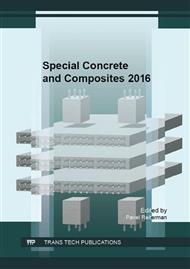p.292
p.298
p.305
p.311
p.316
p.325
p.331
p.337
p.343
Effect of Placement Method on Projectile Impact Resistance of UHPFRC
Abstract:
This paper presents the results of an experimental investigation of the impact resistance of UHPFRC slabs. The influence of horizontal and vertical casting of thin slabs against penetration by a projectile is described. The resistance of penetration by a projectile was investigated using projectile with lead core. The results indicate different penetration depths and crater diameters in the target specimens for both kind of casting. Which points on a different arrangement of fibers for horizontal and vertical casting slabs. However, the protective ability is guaranteed in both placement method. Based on the present findings the slabs from ultra-high performance fiber-reinforced concrete casted vertically appear to be most efficient in protection against projectile impact.
Info:
Periodical:
Pages:
316-321
Citation:
Online since:
December 2016
Authors:
Price:
Сopyright:
© 2017 Trans Tech Publications Ltd. All Rights Reserved
Share:
Citation:


